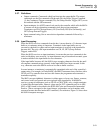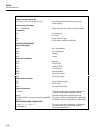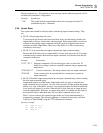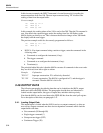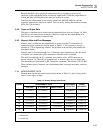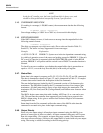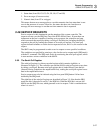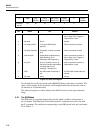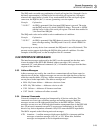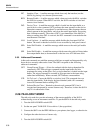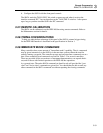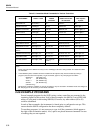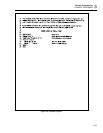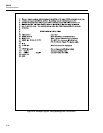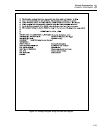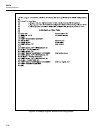
Remote Programming
INTERFACE MESSAGES
3
3-29
The SRQ mask can enable any combination of serial poll register bits 1 through 6. Its six-
bit binary representation is ANDed bit-for-bit with serial poll register bits 1 through 6
whenever the output buffer is loaded. If any mask-enabled bit in the serial poll register
comes true, the RQS bit (bit 7) is set true, generating a service request.
Example Explanation
"* N4 P1 ?" An SRQ is generated if the front panel SRQ button is pressed. The string
sets the SRQ mask to 04, which is 000100 in binary. This mask is ANDed
with the lower six bits of the serial poll register. The mask thus enables bit
3, the Front Panel SRQ bit.
The SRQ mask codes can be added to select combinations of conditions.
Example Explanation
"* N5 P1 ?" An SRQ is generated if the SRQ button is pressed or if the trigger results
in an overrange reading. The SRQ mask is set to 05, which is 000101 in
binary.
At power-up or on any device-clear command, the SRQ mask is set to 00 (decimal). This
prevents service requests by holding the RQS bit false under all conditions. For other
examples of the SRQ mask, see the description of the P1 command.
3-52. INTERFACE MESSAGES
The interface messages understood by the 8842A can be separated into the three main
classes described in the IEEE-488 Standard: address messages (AD), universal
commands (UC), and addressed commands (AC). All interface messages described here
originate at the controller.
3-53. Address Messages
Address messages are used by the controller to communicate talk and listen control to
other devices on the bus. Address messages are sent over the eight data lines of the bus
while the controller holds ATN true. Address messages are processed immediately and
are not placed in the input buffer. The address messages are:
• MLA My Listen Address -- Addresses a device to listen
• MTA My Talk Address -- Addresses a device to talk
• UNL Unlisten -- Addresses all listeners to unlisten
• UNT Untalk -- Addresses all talkers to untalk
3-54. Universal Commands
Universal commands are accepted and interpreted by all devices on the bus. The
commands are of two types, multiline messages and uniline messages. Multiline
messages are sent over the eight parallel data lines in the IEEE-488 bus. Uniline
messages are sent over one of the individual interface management lines in the IEEE-488
bus. All universal commands except DCL are processed immediately by the 8842A,
ahead of any device-dependent commands. Only DCL enters the 8842A input buffer.
The 8842A responds to the following universal messages:
ATN Attention -- A uniline message which causes the 8842A to interpret multiline
messages as interface messages (AD, AC, or UC). When false, multiline
messages are interpreted as device-dependent messages.



